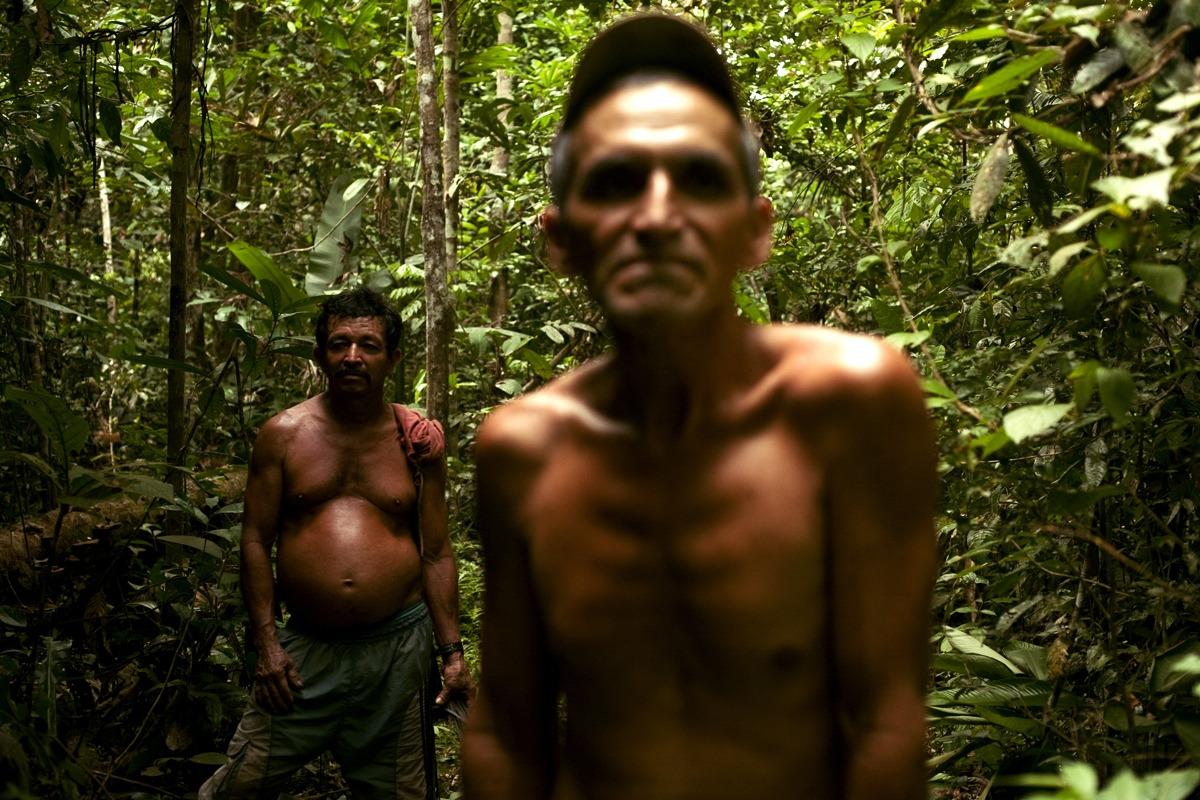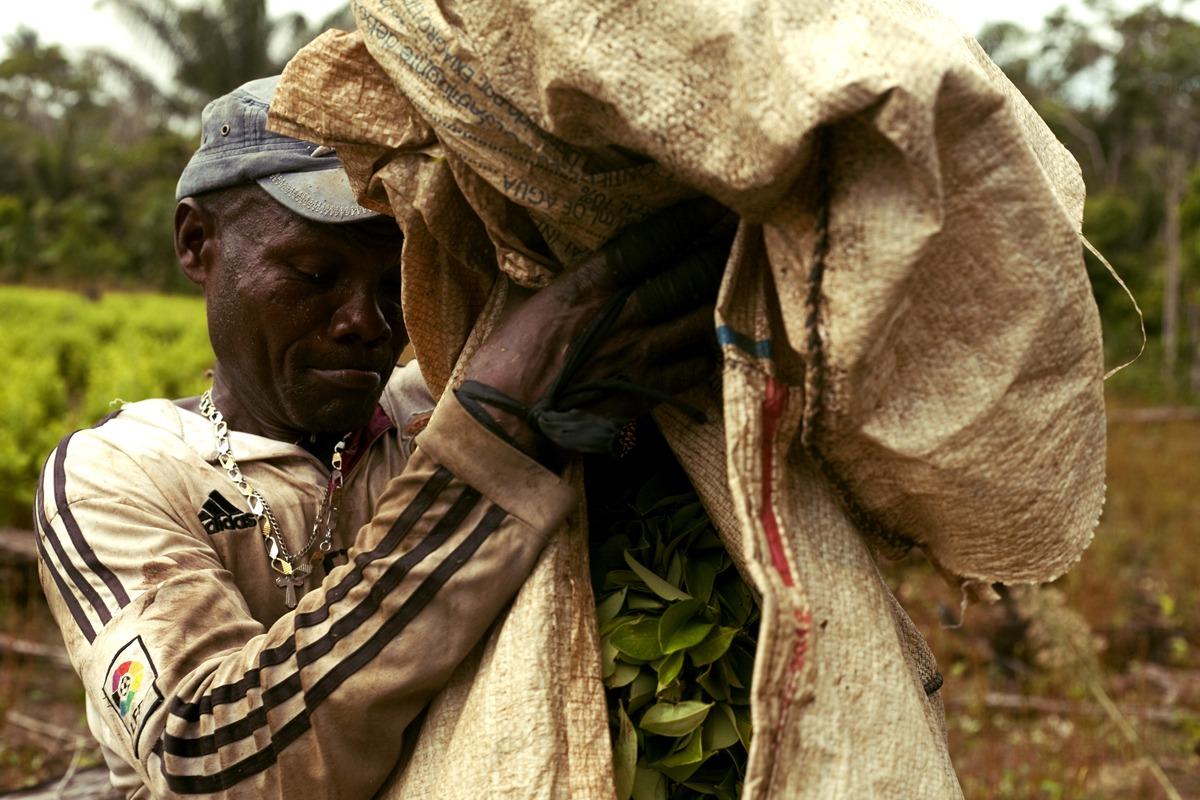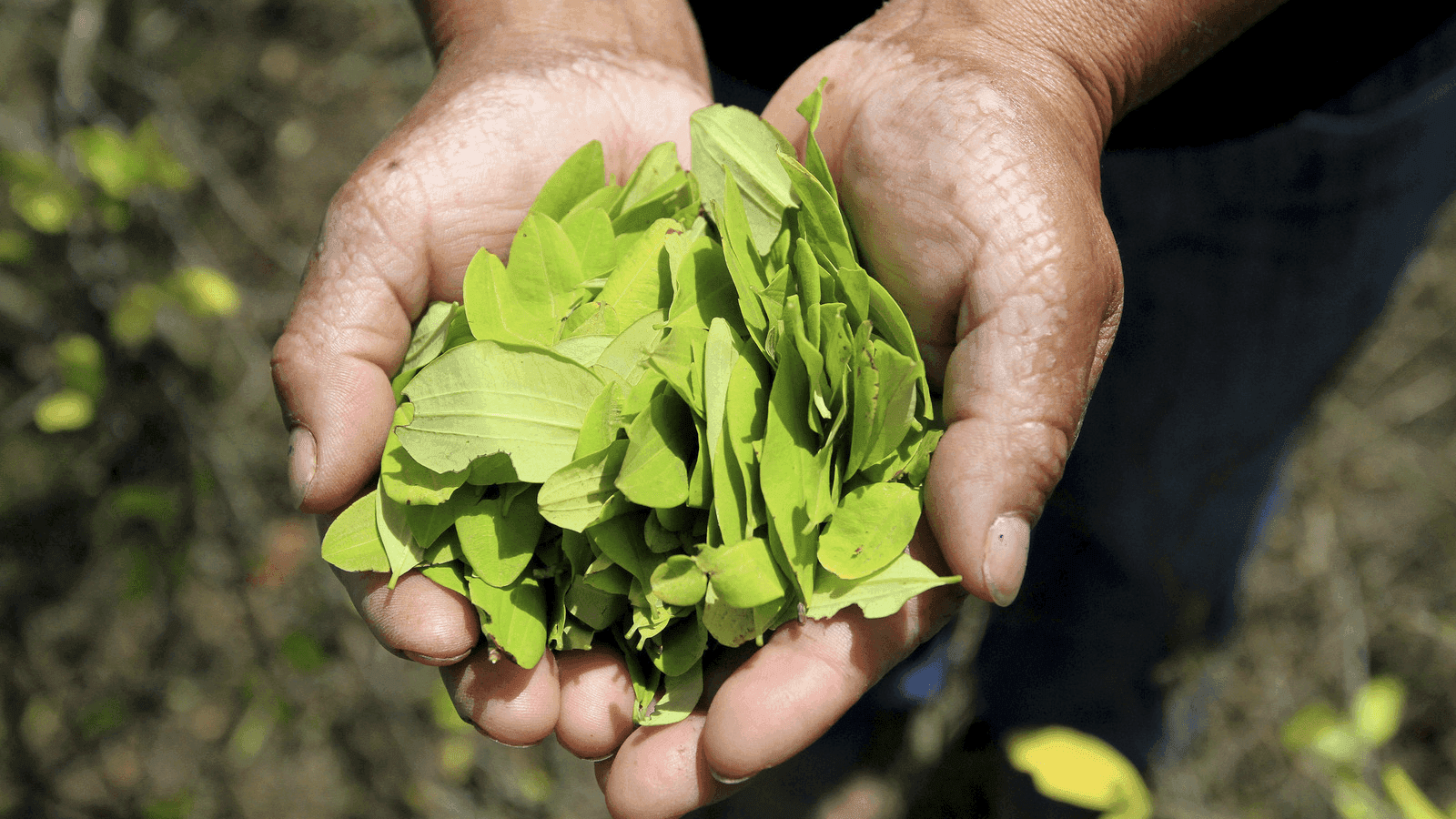A push to legalize coca leaf production in Colombia
Josefina Pabi shows coca leaves that she had collected in her garden in Toribio, Colombia, Sept. 26, 2012.
Coca leaf, the substance used to make cocaine, should be legalized in Colombia in order to aid the peace process and help grow the country’s economy, a new report argues.
The report, titled “Coca Industrialization: A Path To Innovation, Development and Peace In Colombia” and published by the US-based Open Society Foundation, is groundbreaking in its suggestions to the Colombian government, which include guaranteeing small coca farmers with protection from prosecution, supporting research into coca’s nutritional properties and promoting the use of coca among indigenous communities.
Over the years, Colombia has taken varying approaches in its attitude towards coca, from taking its lead from the US and implementing forced eradication through spraying coca fields, to paying farmers to switch to other crops such as cocoa and bananas — which actually increased coca production.
Dora Lucila Troyano Sánchez, one of the report’s co-authors, was the first person to obtain a permit to legally purchase, transport and stock raw coca leaves for their transformation into licit goods — such as fertilizer and coca flour — to be used in scientific research.
Organic coca fertilizers and pest control products were found by the researchers to be a “promising” low-cost, high-nutrient technology that can contribute to local food production in areas with poor soil conditions and high food costs.
“We had to study the feasibility of the markets for selling coca. We had to look at how opportunities could be created for this new economy, how alternative sources of income could be made to supplement the money coca farmers would have earned from selling their crops to armed groups for the illicit trade.”
The South American country has long been losing the battle against cocaine.
According to the World Bank, Colombia is among 10 of the world’s countries with the highest levels of income inequality. Rural communities in Colombia, such as the coca farming community, especially suffer from scant employment opportunities, training and infrastructure.
A cultural tradition and agricultural product
In viewing coca as an agricultural product with ample opportunities to transform coca into natural medicine, agro-industry uses and as a nutritional agreement, coca farmers, who often live below the poverty line, will be granted legal means of earning a living, the report argues.
“It’s important that the world understands in the South Andean regions of Latin America such as Bolivia, Colombia and Peru, indigenous and campesino communities have used and traded coca historically for various uses,” says Herney Ruíz, a coca farmer from Cauca.

“Monetarily, traditionally and spiritually, coca plays an important role in Andean communities. Not only that, but it’s extremely nutritious and has many medicinal benefits.”
Coca has not always been synonymous with narco-trafficking. A sacred plant used in ancient indigenous traditions, the coca leaf has been chewed, brewed and ground for almost 8,000 years by communities in the Andean region.
In 1961, the United Nations’ Single Convention on Narcotic Drugs turned the humble leaf into an illegal commodity, stating: “the Parties shall so far as possible enforce the uprooting of all coca bushes which grow wild. They shall destroy the coca bushes if illegally cultivated.”
Colombia has suffered its fair share of bloodshed in the war against drugs. The 50-year-long civil war, although triggered by political and socio-economic issues in poor communities, was exacerbated by the presences of drug-trafficking groups. More than 200,000 people were killed, while six million have been internally displaced. A peace agreement between the rebel forces and the government was signed in 2016.
It’s not about legalization
David Restrepo, Troyano Sánchez’s fellow co-author of the report, is keen to emphasize that the coca reform process is not about legalization; instead, it is led by rural communities’ own definition of their needs.
“A territory-focused, consensus-based, led-locally process would help strengthen these communities and result in lower conflict and violence. This approach would provide communities the opportunity to bolster their local organization and governance structures.
“By strengthening farmers as farmers, this kind of policy process helps separate coca growers from the rest of the cocaine supply chain. Let’s remember both armed groups and traffickers make their profits primarily from cocaine manufacturing and shipment — not coca cultivation.”
Restrepo is keen to highlight the researchers are not as naive as to think coca reform could provide the answer to ending the war on drugs.
“This coca reform is a key part of building peace in Colombia. However, there are other issues — such as land concentration, poverty and political exclusion that triggered Colombia’s war and were aggravated from the profits of cocaine trafficking, which will remain as long as cocaine is illegal.
“These issues exceed the scope of coca reform, which is why we must not be naive. That said, Colombia’s many-layered, complicated conflicts need to be handled piecemeal — and addressing coca via a community-centered approach is a necessary and urgent matter.”
Colombia’s “war on drugs” was technically and financially supported by the US government, which spent around $10 billion over 15 years to fight narcotics in its “Plan Colombia.” As part of the battle, the Colombian government began a systemic “forced eradication,” whereby coca crops were sprayed from the air with pesticides. But in 2016, the amount of cocaine produced in Colombia went up: 866 tons versus 649 in 2015, which is the same level of production as 2001, when Plan Colombia was just getting underway.
The Colombian government has pledged to eradicate 65,000 hectares of coca in 2018 alone, but efforts have already resulted in violence, with coca farmers saying the renewed forced eradication breaks previous agreements that stated eradication would be through voluntary crop substitution.
‘High cost in human life’
“It was necessary to rethink the policies that have previously been used to tackle illicit cocaine production,” Troyano Sánchez says. “The policies used so far have only made battling the conflict more expensive. Colombia has also paid a high cost in human lives in the war against drugs, and fighting it in this certain way has led to the problem simply growing. This is because the root of the conflict has been ignored.
“We have to rethink the whole idea of local economies in these rural areas, facilitate coca farmers interactions with licit buyers, and encourage the construction of their own economies which can become self-sufficient.”

The report highlights why now is the time to try community-centered reform: the peace agreement provides the legal and institutional framework necessary to try such a pioneering process.
Restrepo explains the consequences of missing such an opportunity: “If Colombia fails to try this approach now, it will remain in the nearly 60-year-old fruitless cycle of trying to impose eradication and crop substitution on rural communities.
“This would spell an escalation of conflict — and erode Colombia’s recent progress.”
Colombia is described by Restrepo as a “global vanguard of drug policy reform,” and remains the biggest coca producer in the world.
But Colombia won’t be the first Latin American country to take a more liberal approach to coca leaf cultivation.
Over the past decade, Peru and Bolivia have taken radical steps to tackle coca reform, including Bolivia dramatically expelling the DEA in 2008. Both countries have led the development of the coca leaf industry, conducting research into its uses, regulating the coca market and even, in the case of Bolivia, launching a government-owned company that buys coca leaf and processes it into flour and other consumables. The country’s industry is based on a local system which ensures coca farmers — also known as cocaleros — keep production volumes within the law, and minimize diversion to the illicit market.
The report holds up Peru and Bolivia as examples of how coca legislation can be successfully implemented.
Peru signed the 1961 Convention with a caveat that it should not be obligated to criminalize coca, and that “chewing of the coca leaf in the country would remain ongoing.”
“Peru’s policy allowed it to lead the development of a coca leaf industry, which turned it into a template for commercializing, registering, and regulating coca,” the report notes.
In late 2017, an essay titled “Cocaine Histories and Diverging Drug War Politics in Bolivia, Colombia, and Peru” was published by Paul Gootenburg, a historian and professor at Stony Brook University.
He noted: “Rather than a unified uniform turn to regional drug reform, a diversity of new drug politics is emerging in the Andes. … Bolivia has become, with open rejection of US-UN models of coca eradication, one of the most defiant nations in the global drug regime … [it] has gained notable internal and external momentum in drug policies.
Gootenburg adds: “It’s also ironic — if predictable — that the United States has failed to recognize the legitimacy of the Bolivian national experiment in drug control, despite evidence it works, probably since it is an open challenge to supply control ideology.”
Speaking to PRI, he said the individual legacies and social conditions of Peru, Bolivia and Colombia “don’t travel” and so pose a separate and unique set of challenges — and possibilities.
“Without much ‘deep’ history of coca in Colombia, the newness of it and foreignness of it could make it either a target for hostile elimination — by foreign or national bodies — or a possible flexibility.”
‘Unrealistic’ plans?
Ana María Rueda is an adviser to Colombia’s drug policy director. She says the legalization of coca is “completely unrealistic.”
“It’s not clear there is a market for coca products that could benefit the communities,” she says.
“Regulating coca for medical or scientific purposes will be much easier. The issue is, we don’t know enough of the medical or industrial uses. Its use as a painkiller has been replaced by other substances, and so it’s believed there is no longer use for it.”
She adds studying the medical cannabis market is essential when looking at legalizing coca as a means for developing rural communities.
“It is already dominated by big businesses, with little advantages to small communities. The government would have to make a very expensive effort to include campesinos in this market. I believe the same thing will happen if we get a global interest on a legal market for coca.”
Rueda says the Colombian government does not yet have the manpower to support campesinos in the production and commerce of coca products.
“It is important to understand that the governability issues in our country are huge, and we are young democracies where the state does not have the capacity to attend everyone’s needs.
“Therefore, if we legalized coca today, the government would have very little control of the market. I don’t think a country like Colombia will have the muscle to become an important player in the world’s economy with any product, and much more difficult with these stigmatized plants.”
More studies still need to be conducted in the nutritional properties of coca before it can hit the international market as a new superfood, but Ruíz and other coca growers have been working with Colombia’s SENA University to research alternative uses for the leaf.
“We have been caught in the mistaken belief that we are part of the cocaine manufacture process when we are not,” Ruíz explains. “Our challenge is to persevere despite the illegal cocaine process and create a legal industry from coca, where we use it for flour, for fertilizer, and for many other things — because it has so many benefits.”
In the 1970s, Harvard University scientists published a paper detailing the benefits of coca, which can provide a natural energy boost, be used as a painkiller or for altitude sickness, as well as containing magnesium, calcium, vitamins A, B1 C and E, and more. Due to the difficulties in obtaining coca leaf and exporting it for legal scientific purposes, little other research has been done since.
“Colombia would be foolish to overlook this promising agricultural product,” concludes Restrepo. “All scientific evidence thus far indicates that coca is a benign, non-addictive, highly effective stimulant with fewer side effects than coffee. It could well ride the wave of previously ignored but now incredibly popular Latin American plants like quinoa, avocados and chia seeds.”
The other challenges is changing perceptions, Ruíz says.
“It’s important that the Colombian government and national and international drugs policy groups understand that there are Andean communities who live off coca leaves,” Ruíz adds. “Our biggest challenge for Colombia, and the world, to recognize these cultural uses, and the health benefits. Once that has happened, then our next challenge will be getting help to generate micro-businesses and open industries that will be managed by Andean communities, to generate legal production and create an economy.
“When that happens, it will be a beautiful thing.”
Our coverage reaches millions each week, but only a small fraction of listeners contribute to sustain our program. We still need 224 more people to donate $100 or $10/monthly to unlock our $67,000 match. Will you help us get there today?
